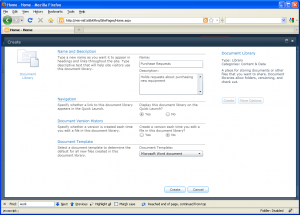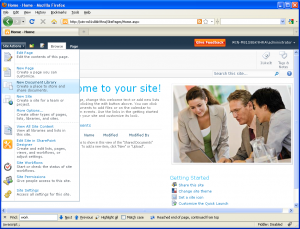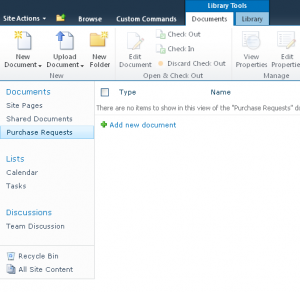Workflows (sequences of connected steps) are an everyday occurrence in most offices and as such, SharePoint 2010 provides support for workflows. In this article we review how to add an approval workflow to a SharePoint Document Library.
The approval workflow is one of the few built-in workflows that come with the SharePoint 2010. Basically it allows you to receive an approval for a document from your superiors.
If you need a custom workflow you can create your own with SharePoint Designer or Microsoft Visio and import it into SharePoint Designer or program it inside Microsoft Visual Studio. How to do this is outside of the scope of the current article.
The sample workflow we are going to build will be triggered upon uploading a new document to a custom document library. Then the workflow will assign a task to a predefined user to approve the uploaded document. The status of the document – approved/rejected will be displayed in one of the columns of the library. And we will do everything without writing a single line of code!
The first step is to create the Document library where the approval workflow will be enabled. To do this, select the “Site Actions” menu and then choose “New Document Library” as shown in Figure 1.

Figure 1 Create New Document Library – Site Actions menu
Next, the dialog for creating a new Document library will appear (Figure 2). Fill in “Purchase Requests” for the “Name” of the new library and optionally provide description. Select the options for “Navigation” and “Document Version History” – whatever fits to your requirements is fine as they are irrelevant to our example. For “Document template”, select “Microsoft Word document”. You can choose whatever you wish but this current example we will use Word documents.

Figure 2 Create New Document Library
After you have filled in everything, click Create and the new document library will be created as shown in Figure 3
Figure 3 Purchase Request Library is created
Now it is time to enable the Approval workflow for our newly created library. To do so select “Library” from the “Library tools” and then select “Workflow Settings” as displayed in Figure 4.
Figure 4 Workflow Settings button
This will start the wizard shown in Figure 5 which will help you to enable the approval workflow for the current document library. The first thing to do is select the workflow template from the list box in the “Workflow” section. You can choose from several out-of-the-box workflow templates but we will choose “Approval – SharePoint 2010”. Then we provide a name for our workflow: “Expense approval”. The task list drop down allows us to define a list where a new task will be assigned to the corresponding user. Let’s use the default value – “Tasks”. Later we will configure the users responsible for approving the documents. Next, we define the history list for the workflow. History lists are special logs which monitor the execution of the workflow. At each step of the workflow, messages at written to the log upon execution of the step. Again, accept the default value, as shown in Figure 5. Now, configure how the workflow is started. Generally, two approaches are possible - manual and automatic. We will use the latter and will deselect the check boxes for manual starting and we will select the checkboxes for automatic starting.
After pressing the next button, we will navigate to the second step of the configuration wizard – Figure 6.
Figure 5 Add workflow – Step 1
Figure 6 Add Workflow – Step 2
Now, we need to configure the users responsible for approving the content (Word files in this case). We will do it by clicking the ‘open book’ icon and select it from a list. In our example the approver will be John. You can also specify user groups, not just single users. If there are multiple users selected, you can choose to approve one at a time or all at a time.
We also need to specify a Notification message. This message will be used to remind the user assigned as an approver, the action he is supposed to take. Something like “Please approve” will be appropriate in this case.
The other fields are not necessary to complete the workflow. If you are curious about these, you can read the detailed explanation below each field.
After pressing the Save button our workflow is ready and it is time to see how it works. To do this, we will upload a new Word document to the document library we have created earlier. Navigate to the “Purchase Requests” via the menu on the left and select “Add new document”. A new popup dialog will appear (Figure 7) where we can select a Microsoft Word document from the local hard drive. Click OK and a popup dialog will appear, where additional properties can be assigned to the newly uploaded file. For example, you can associate some keywords with it.
Figure 7 Upload Document
As you can see from Figure 8 our file has been uploaded to the document library and the last column shows that the Expense approval workflow is in progress. This means that a new task has been assigned to John (the user we specified early as an approver). If we open the Tasks List (Figure 9), we will note that there is a new task with the title “Please approve Backup Server” assigned to John. If SharePoint is configured to use the SMTP server, John will receive an email that informs him of the new task.
Figure 8 Newly uploaded document that has started the workflow
Figure 9 Approval Task Assigned to John
Now, let’s suppose we have logged in as John. After opening the “Please approve the Backup Server” task a new popup window will appear – Figure 10. We can approve or reject the document by clicking Approve/Reject . In addition, we have the option to assign the task for approving the document to another user. For this demo we will approve the document by clicking Approve.
Figure 10 Document Approval Dialog
Now, after John has approved our document, we can go back to the “Purchase Requests” document library and check the status of our document. You will notice that the last column now shows “Approved”.
Figure 11 Document is approved
In this article we have reviewed how to configure an approval workflow for a custom document library. The workflow was started automatically after a new document was uploaded. If you need a more sophisticated workflow, you will need to use the SharePoint Designer or Visual Studio to create one. The last approach is far more complicated and requires programming skills.











No comments:
Post a Comment